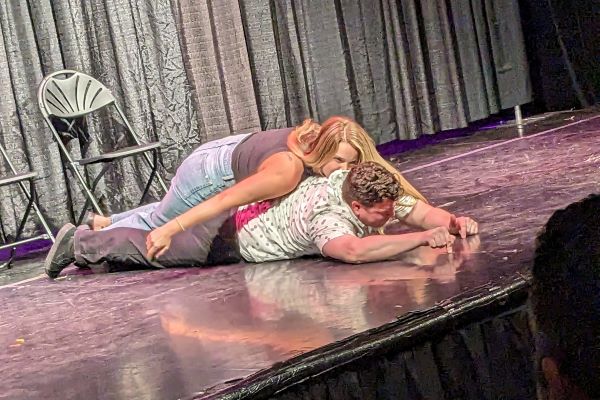
Heightening is the wonderful magic sauce that makes improv so fun to watch and perform. Heightening is how we play the game of the scene, how we move forward in the scene, and how we ultimately end the scene.
Finding the Direction to Heighten
In our Formula of Improv we say that we heighten on a stairway to heaven, or a highway to heck. That can be a little misleading. The way we heighten depends on the game of the scene, or what weird or unusual thing we choose to bear hug. Once we’ve discovered the game, usually accompanied by a laugh from the audience, we want to play that game as many times as possible until the scene gets edited. We do that by heightening that weird or unusual thing in one direction or another. This can look a lot of different ways—we might be making this the best (or worst) day ever for one of the characters, we may be finding new ways to be bad at our job, or new ways to annoy our parents. No matter the direction, we want to decide on one direction (!) and continue in that direction for the duration of the scene. We’re only ever headed to heaven or heck, so to speak, never to both. Well, David, you might be asking the ether, how do we know when to stop heightening? I’m glad I wrote that you asked.
The Rule of Three
Comedy works in threes. No one knows why, like algebra, it’s a gift from the cosmos, but it does. The rule of three in improv is the rule of AT LEAST three. When we find the game that we’re going to be heightening, we want to play that game at least three times. You might be able to play it twenty three times, which is great, but we’ll find that if we only play it twice, we, and our audience, will be left feeling unfulfilled (comedically). The reason for this is that when we establish the game, or choose the weird or unusual thing that we’re going to bear hug, we have played the first beat of the game. The audience laughs somewhat unexpectedly for the first beat, giving us an indicator that we should play that game some more. The second beat, that is to say the first time we heighten the game, firmly establishes what the audience can expect from us for this scene. Now that they know what to expect, we want to deliver on that promise at least one time, our second heighten and our third beat. When we do, we get a different type of laugh from the audience, a laugh that rewards us for doing what they expected us to do. We are often a few seconds ahead of the audience because we train for this, so we often give them what they know is coming but haven’t yet been able to fully process. We surprise them with what they know is going to happen. It’s one of the many reasons why improv comedy in a world of its own. Well, David, you might be raging to the ether, you still haven’t actually told us when to stop heightening and end the scene. Thank you for your rage fueled insistence, imaginary reader.
Editing
In our school, we teach the sweep edit. It’s the most common way to end a scene, and if you’ve seen any improv, you’ve likely seen it performed. One person will run across the downstage edge of the performance area, ending that scene, sweeping the stage clear for a new scene to begin. I was taught to look for at least one of four things when editing—a pop, a button, the resolution of our rule of three, or tanking.
The Pop Edit
A pop is an unexpected laugh form the audience that is so pleasantly disruptive that we have to end the scene. This often happens when we make a “mistake” on stage. Mistake is in quotations because those “mistakes” are often the greatest gifts of all. We misspeak, we surprise ourselves with the reaction our character has to something in the scene, or we just can’t contain ourselves and break into laughter on stage. All of these are good reasons to end the scene with a pop sweep edit. If you’re not in the scene and a pop edit presents itself, you will likely feel the urge to run across the stage. Trust your feet.
The Button Edit
A button edit is a piece of contextual information that makes it feel like the scene has wrapped up. We don’t care about narrative in improv, we never need to end the transaction, or work our way through the climax (comedically) to the denouement. Occasionally, we’ll get an endowment late in the scene that puts everything we’ve just watched into perspective (they’ve been fish this whole time?! or they’ve been in space this whole time?!) This context gets us a big laugh because the audience gets to reprocess everything they’ve just heard in this new light and they react to that absurdity. When that happens, the scene is almost always over. Moving forward from this point would likely feel like a brand new scene, so it’s best to sweep the stage and move on.
The Resolution of our Rule of Three
This edit is most closely related to our heightening discussion. If our teammates have really made it clear what the game of the scene is, and are moving through the beats of that scene smoothly, the end of the scene happens after the third beat. Again, it could be on the twenty third beat of the scene, but it shouldn’t be on the second. Often, when the game is communicated clearly, just the mention of the third beat will get a big reaction from the audience because they’re now able to fill in the blanks of how the characters would react to that endowment if the scene continued. We are now free to edit. The reactions to the third beat offer would have gotten the same laughter that we just got by simply mentioning the third beat offer, so the scene can be safely swept clean. This begins to feel a little like sitcom comedy when done right; we learn what to expect from the characters and set them up to do their thing. The only difference being we’re making it up on the spot and not in a writer’s room!
Tanking
The threat of failure is ever present in improv. No matter how long you perform, or how many classes you take, there is always the danger of having a bad scene. It’s nothing to be ashamed of, and certainly not an indicator of your failure as an improviser. It’s just part of the joy of making things up on the spot. When that happens, though, we don’t want to force ourselves or our teammates to live in that bad scene for any longer than they have to. It’s our responsibility to edit the scene and get them out of there. This is a difficult edit to perform. It’s the only edit that is probably not going to be paired with a laugh from the audience, and can feel cruel. Not only is it not cruel, it’s the nicest thing you can do for a teammate in a bad scene. End the scene and move on. It’s always better to edit a scene too early than too late.
Now, dear reader, are you satisfied that you’ve been given the tools to use heightening to play the game of the scene for as long as you can, and that you now know when, how, and why to stop heightening and end the scene? Great. Now go play.
